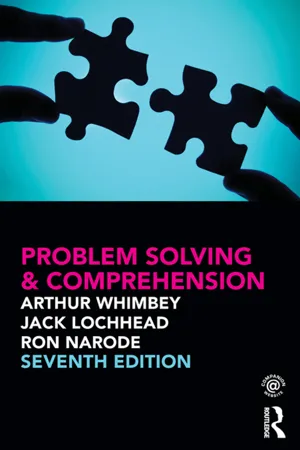
- 426 pages
- English
- ePUB (mobile friendly)
- Available on iOS & Android
Problem Solving & Comprehension
About This Book
This popular book shows students how to increase their power to analyze problems and comprehend what they read using the Think Aloud Pair Problem Solving [TAPPS] method. First it outlines and illustrates the method that good problem solvers use in attacking complex ideas. Then it provides practice in applying this method to a variety of comprehension and reasoning questions, presented in easy-to-follow steps. As students work through the book they will see a steady improvement in their analytical thinking skills and become smarter, more effective, and more confident problem solvers. Not only can using the TAPPS method assist students in achieving higher scores on tests commonly used for college and job selection, it teaches that problem solving can be fun and social, and that intelligence can be taught.
Changes in the Seventh Edition: New chapter on "open-ended" problem solving that includes inductive and deductive reasoning; extended recommendations to teachers, parents, and tutors about how to use TAPPS instructionally; Companion Website with PowerPoint slides, reading lists with links, and additional problems.
Frequently asked questions
Information
1. Test Your Mind—See How It Works

Wasi Test Whimbey Analytical Skills Inventory
Instructions
- If you started with $25.00 and then spent $3.00 to go to a movie, how much would you have left?
- $23.00
- $22.00
- $21.00
- $12.00
- Circle the fifth word in this sentence.
- Which word is different from the other 3 words?
- yell
- talk
- pencil
- whisper
- Which letter is as far away from K in the alphabet as J is from G?
- K
- M
- N
- G
- I
- If you are facing east and turn left, then make an about-face and turn left again, in which direction are you facing?
- east
- north
- west
- south
- southwest
- Which pair of words fits best in the blanks? Arm is to wrist as _________ is to ______________ .
- leg: foot
- thigh: ankle
- leg: ankle
- leg: knee
- 20 is related to 30 as 10 is related to ________?
- 5
- 25
- 60
- 15
- 10
- Which set of letters is different from the other 3 sets?
- EFGE
- BCDB
- KLML
- OPQO
- In a different language liro cas means "red tomato," dum cas dan means "big red bam" and xer dan means "big horse." What is the word for barn in this language?
- dum
- liro
- cas
- dan
- xer
- Write the 2 letters which should appear next in the series.

- 9. There are 3 separate, equal-size boxes, and inside each box there are 2 separate small boxes, and inside each of the small boxes there are 4 even smaller boxes. How many boxes are there altogether?
- 24
- 13
- 21
- 33
- some other number
- 10. Ten full crates of walnuts weigh 410 lb, while an empty crate weighs 10 1b. How much do the walnuts alone weigh?
- 400 lb
- 390 lb
- 310 lb
- 320 lb
- 420 lb
- 11. One number in the series below is incorrect. What should that number be?

- 33
- 7
- 24
- 31
- 32
- 12. The first figure is related to the second figure in the same way that the third figure is related to one of the answer choices. Pick the answer.

- 13. Which pair of words best fits the meaning of the sentence?
- ____________ the dog was big, he was ____________ heavy.
- Since...
Table of contents
- Cover
- Title
- Copyright
- Dedication
- Contents
- Preface to the Seventh Edition
- Preface to the Sixth Edition
- 1. Test Your Mind—See How It Works
- 2. Errors in Reasoning
- 3. Problem-Solving Methods
- 4. Verbal Reasoning Problems
- 5. Six Myths About Reading
- 6 Analogies
- 7. Writing Relationship Sentences
- 8. How to Form Analogies
- 9. Analysis of Trends and Patterns
- 10. Deductive and Hypothetical Thinking Through Days of the Week
- 11. Solving Mathematical Word Problems
- 12. Open-Ended Problem Solving
- 13. The Post-WASI Test
- 14. Meeting Academic and Workplace Standards: How This Book Can Help
- 15. How to Use Pair Problem Solving: Advice for Teachers, Parents, Tutors, and Helpers of All Sorts
- Appendix 1. Answer Key
- Appendix 2. Compute Your Own IQ
- References